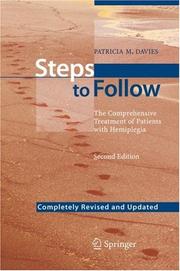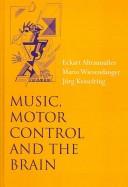| Listing 1 - 4 of 4 |
Sort by
|
Book
ISBN: 9780511575051 9780521480185 Year: 1997 Publisher: Cambridge Cambridge University Press
Abstract | Keywords | Export | Availability | Bookmark
 Loading...
Loading...Choose an application
- Reference Manager
- EndNote
- RefWorks (Direct export to RefWorks)

ISBN: 354060720X 3642570224 9783540607205 Year: 2000 Publisher: Berlin Springer
Abstract | Keywords | Export | Availability | Bookmark
 Loading...
Loading...Choose an application
- Reference Manager
- EndNote
- RefWorks (Direct export to RefWorks)
This new edition of a best-selling guide incorporates significant advances in the early and later rehabilitation of neurologically impaired patients. Based on the Bobath concept, Davies' approach to rehabilitation stresses the need to equip the patient for a full life, rather than setting arbitrary goals for functioning in a sheltered environment. Activities are described for correcting abnormal movement patterns and facial difficulties. Ways to regain walking, balance and other normal movement sequences are explained and demonstrated with 750 photographs of patients being treated.
Physiotherapy. Alternative treatments --- kinesitherapie --- hemiplegie --- Hemiplegics --- Rehabilitation --- Medicine. --- Neurology. --- Nursing. --- Occupational Therapy. --- Physical therapy. --- Health Services --- Physical Medicine --- Therapeutics --- Investigative Techniques --- Paralysis --- Neurologic Manifestations --- Analytical, Diagnostic and Therapeutic Techniques and Equipment --- Health Care Facilities, Manpower, and Services --- Medicine --- Health Care --- Signs and Symptoms --- Health Occupations --- Nervous System Diseases --- Pathological Conditions, Signs and Symptoms --- Diseases --- Disciplines and Occupations --- Methods --- Hemiplegia --- Health & Biological Sciences --- Neurology --- Physiotherapy. --- Neurology . --- Occupational therapy. --- Activity programs, Therapeutic effect of --- Occupation therapy --- Work, Therapeutic effect of --- Medical rehabilitation --- Physical therapy --- Psychotherapy --- Therapeutics, Physiological --- Clinical nursing --- Nurses and nursing --- Nursing process --- Care of the sick --- Nervous system --- Neuropsychiatry --- Hemiplegie.

ISBN: 0199298726 9780199298723 0198530005 9780198530008 Year: 2006 Publisher: Oxford Oxford university press
Abstract | Keywords | Export | Availability | Bookmark
 Loading...
Loading...Choose an application
- Reference Manager
- EndNote
- RefWorks (Direct export to RefWorks)
The motor actions that can be witnessed as a virtuoso musician performs can be so fast, so accomplished, so precise, as to seem somehow superhuman. The musician has to produce the movements, monitor those they have already made and the subsequent result, co-ordinate their hands, fingers, eyes, and perhaps throat and diaphragm. These achievements are of course the product of hundreds, even thousands of hours of practice-playing scales, studies, time and time again. But those hours of practice by no means guarantee that great musicianship will result. This technical prowess has to be combined with a range of other, perhaps, less tangible qualities. This book explores the secrets of musical virtuosity. It presents a comprehensive account of music and motor cognition, examining the neural basis of music making - our understanding of which is just starting to be enhanced by brain imaging. It considers the effect on our brains of prolonged music making. It explores the motor processes across a range of instruments (vocal, string, wind, percussion) and within different performance situations. It also considers what happens when things start to go wrong - why motor problems occur in so many professional musicians in later life, and the possible therapies for such problems. Music is a topic of considerable interest within the brain sciences. With contributions from leading psychologists, neuroscientists, and neurologists, this book makes a unique contribution to our understanding of music and the brain.
Music --- Sensorimotor integration. --- Motor Activity --- Music. --- Brain --- Psychomotor Performance. --- Physiological aspects. --- Psychological aspects. --- physiology. --- Musique --- Intégration sensorimotrice --- Aspect physiologique --- Aspect psychologique --- Motor activity --- Intégration sensorimotrice --- Sensorimotor integration --- Integration, Sensorimotor --- Intersensory integration --- Perceptual-motor integration --- Sensimotor integration --- Sensory integration --- Sensory-motor integration --- Music psychology --- Music physiology --- Physiological aspects of music --- Physiological aspects --- Psychological aspects --- Psychology --- Perceptual-motor processes --- Sensory integration dysfunction
Book
ISBN: 9780521888325 9780511781698 Year: 2010 Publisher: Cambridge Cambridge University Press
Abstract | Keywords | Export | Availability | Bookmark
 Loading...
Loading...Choose an application
- Reference Manager
- EndNote
- RefWorks (Direct export to RefWorks)
"Recent developments in basic and applied science have led to better understanding of disease mechanisms and more efficient therapies for multiple sclerosis. The most effective way of managing these patients is through a carefully planned neurorehabilitation programme. The main aims are to reduce disability and handicap and improve functions through effective training, stimulating activity and social participation. As the first text on recovery of function and neurorehabilitation in MS, this book focuses on mechanisms of recovery, application of neuroplasticity to therapeutic interventions, and determination of the efficiency of these interventions. Basic principles of neurorehabilitation in MS are described, as well as techniques for treating specific syndromes which may occur in MS. Written and edited by leading clinicians and researchers, the book achieves an excellent balance between basic science, pathophysiology, and clinical rehabilitation. An essential resource for clinicians and therapists treating patients with multiple sclerosis, neurophysiologists, and health care advisors"--Provided by publisher.
| Listing 1 - 4 of 4 |
Sort by
|

 Search
Search Feedback
Feedback About UniCat
About UniCat  Help
Help News
News